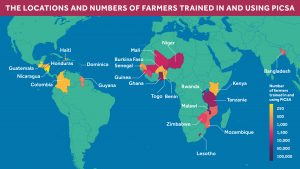PICSA in Practice
Demand for PICSA in practice has recently surged. Regional organisations, governments, and non-governmental organisations around the world are interested in using PICSA. Typically, this involves including PICSA in new or existing projects that aim to help farmers cope with climate variability and change.
Where does PICSA work?
PICSA has thus been implemented in 20 different countries, and has reached tens of thousands of farmers across Sub-Saharan Africa, Latin America, and South Asia. Recent evaluations have indicated that PICSA has been successful in the countries where it has been implemented.

PICSA’s Supporters
Our aim is for local organisations to take ownership of PICSA, and thus ensure its sustainability in their own countries. However, as with many development interventions, some outside assistance has been needed at the start. The development and implementation of PICSA has been strongly supported by Nuffield Foundation, Climate Change Agriculture & Food Security (CCAFS) and United Nations World Food Programme (WFP), for which we are very grateful.
PICSA has also been graciously supported by:
- The International Centre for Tropical Agriculture (CIAT)
- Climate Services for Resilient Development (CSRD)
- DeltaCAP
- Global Framework for Climate Services (GFCS)
- Practical Action
- Rockefeller Foundation
- United Nations Development Programme (UNDP)
- United Nations International Fund for Agricultural Development (IFAD)
- USAID
- World Agroforestry (ICRAF)
PICSA’s Future
PICSA is now at a crucial stage in its development. This recent upsurge in interest represents a significant opportunity to make a major impact on a key global challenge. However, to meet this demand whilst maintaining the quality and long-term sustainability of PICSA, it is essential to understand the effects of implementing PICSA in new countries, as well as to continue developing and improving the approach and its delivery as it expands.
